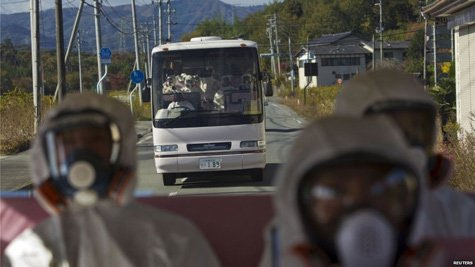Journey to the land of
Fukushima has been the world's worst nuclear disaster since 1986. After the tsunami in March, a nuclear power plant here was damaged, causing radioactivity to leak into the air and soil. and the sea, causing thousands of people to leave their homes to evacuate.
Recently, special visitors including French Minister of Energy and Industry, Eric Besson and the delegation were led to visit deserted towns around Fukushima nuclear plant by bus. A factory employee - in a tight white protective suit - came along to guide the group, raising his hand to show the level of radiation rising.
Entering the disaster-stricken area, visitors can find many houses like normal houses anywhere in Japan. But the difference is that nobody has lived there for almost a year now. Occasionally a pet appears in the garden. It must be hard to maintain existence because its owner has evacuated this dangerous area to be safe from March.
The visitors and an AFP reporter sat quietly on the bus, in a costume designed to avoid the risk of radiation exposure to the skin, clothing or hair. They saw pine trees standing in line at the entrance to Fukushima Daiichi factory - the name that caught the attention of the world community since the worst nuclear disaster in 25 years occurred.

Entering the disaster-stricken area, visitors may encounter many houses
The house is like normal houses anywhere in Japan.
Radiation levels are increasing. Some tourists seem anxious and adjust their clothing more closely on their necks. After that, they were given a full face mask to protect their eyes, nose and mouth.
The hydrogen gas explosion after the tsunami in March destroyed nuclear power plants, while contributing to creating metal fragments and rubble around the building.
The trip took five minutes to reach the center to control the nuclear power plant. The building is arranged about 3,000 employees around. Part of them is tasked with overpowering the reactors. At the central control room, French Minister of Energy and Industry, Eric Besson was informed of the effort to cool down the nuclear reactor. A project that the most optimistic person also thinks takes several decades.
Mr. Besson is the first foreign politician to set foot inside the factory since the disaster. He called for courage from Tokyo Electric Company employees and workers who spend most of their time in the factory area.
'In France, nuclear energy meets 80% of electricity demand. Therefore, the disaster at Fukushima nuclear plant is a big warning. However, we continue to believe in a safe and secure civilian nuclear energy program. We are relying on you to revive this field, " Besson told workers.
For Japan, it is difficult for us to soon come up with an effective solution to the energy problem. In addition to a number of independent reactors, the reactors left in 54 reactors operating throughout Japan also raised public concerns about technology safety. March 11 is the anniversary of a year of tsunami disaster in Japan, we hope everything will be better.
Returning to the bus, the minister and his delegation removed their masks. The instructor showed them the radiation measurements again.
The attentive passenger looked out the bus window as they passed through the factory gate and returned to the uninhabited land surrounding the building - where tens of thousands of people were forced to leave their homes to Be safe.
Some areas here, people will be allowed to return next year but some places will not be able to stay within 30 years.
The bus continues its journey back, passing through empty villages and abandoned houses. And the level of radiation begins to decrease.
- People will land on an asteroid before 2020
- The Earth is about to lose 1/3 of its food land
- The Mars probe is ready to land
- NASA's seven-minute scare is about to land on Mars
- Cross the Antarctic according to Shackleton's journey
- What would happen if the Earth's sea and land swapped? Hell is full of centipedes waiting for you
- Vietnam and ASEAN use peat land sustainably
- The tiny piece of private land is only 0.32m2 wide in the US city
- The incredible journey of sea turtles
- A quarter of the world is degenerating
- Rosetta spacecraft and 6 billion km journey to comets
- Strangely, fishes like to walk on land
 'Fine laughs' - Scary and painful torture in ancient times
'Fine laughs' - Scary and painful torture in ancient times The sequence of numbers 142857 of the Egyptian pyramids is known as the strangest number in the world - Why?
The sequence of numbers 142857 of the Egyptian pyramids is known as the strangest number in the world - Why? History of the iron
History of the iron What is alum?
What is alum?